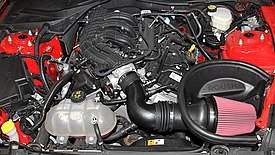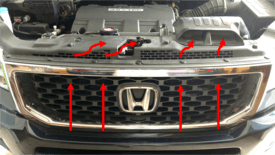Cold air intake


A cold air intake (CAI) is usually an aftermarket assembly of parts used to bring relatively cool air into a car's internal-combustion engine.
Most vehicles manufactured from the mid-1970s until the mid-1990s have thermostatic air intake systems that regulate the temperature of the air entering the engine's intake tract, providing warm air when the engine is cold and cold air when the engine is warm to maximize performance, efficiency, and fuel economy. With the advent of advanced emission controls and more advanced fuel injection methods modern vehicles do not have a thermostatic air intake system and the factory installed air intake draws unregulated cold air. Aftermarket cold air intake systems are marketed with claims of increased engine efficiency and performance. The putative principle behind a cold air intake is that cooler air has a higher density, thus containing more oxygen per volume unit than warmer air.
Design features
Some strategies used in designing aftermarket cold air intakes are:
- Reworking parts of the intake that create turbulence to reduce air resistance.[2]
- Providing a more direct route to the air intake by eliminating muffling devices.
- Shortening the length of the intake.
- Placing the intake duct so as to use the ram-air effect to give positive pressure at speed.[3]
Construction
Intake systems come in many different styles and can be constructed from plastic, metal, rubber (silicone) or composite materials (fiberglass, carbon fiber or Kevlar). The most efficient intake systems utilize an airbox which is sized to complement the engine and will extend the powerband of the engine. The intake snorkel (opening for the intake air to enter the system) must be large enough to ensure sufficient air is available to the engine under all conditions from idle to full throttle.
The most basic cold air intake consists of a long metal or plastic tube leading to a conical air filter. Power may be lost at certain engine speeds and gained at others. Because of the reduced covering, intake noise is usually increased. Here is what is usually included into the cold air intake kit:
- air filter;
- hoses and clamps;
- intake tube;
- washers;
- heat shield[4].
The exact box contents depends on the year, make and model of the vehicle the CAI is designed for. The majority of cold air intakes feature the filters, that don’t have to be replaced, but may be washed with a special cleaner. This makes filter reusable and allows keeping it clean throughout its lifespan. On the other hand, there is a danger that the owner can forget to maintain their air intake in time. If this happens, the chances are high that debris and particles may get into the engine with air and cause scratches inside of the engine. Such scratches may lead to further oil leakage.
Some intakes use heat shields to isolate the air filter from the rest of the engine compartment, providing cooler air from the front or side of the engine bay. This can make a big difference to intake temperatures, especially when the car is moving slowly.[5] Some systems, called "fender mount," move the filter into the fender wall instead. This system draws air up through the fender wall which provides even more isolation and still cooler air.
See also
References
- ↑ 2006 Honda Ridgeline introduction (part 3 of 4), Ridgeline's Chief Engineer (Gary Flint) introduces the Ridgeline, YouTube, by The Temple of VTEC, posted by Jeff Chambliss on 1 August 2009, last accessed 16 August 2015
- ↑ Knowling, Michael (November 16, 2007). "Shielded Sucker: A cheap and easy air intake improvement - with no CAI pipe in sight!". AutoSpeed. Retrieved 2013-04-15.
- ↑ Edgar, Julian (July 10, 2001). "Siting Cold Air Intakes: Simple testing to find the best place to put the mouth of the cold air intake". AutoSpeed. Retrieved 2013-04-15.
- ↑ "K&N Performance Air Intake 77 Series Installation Instruction" (PDF). CARiD.com.
- ↑ "Air Filter Heat Shield Test – Do Heat Shields Make a Difference? – StrikeEngine". Strikeengine.com. Retrieved 2013-10-14.